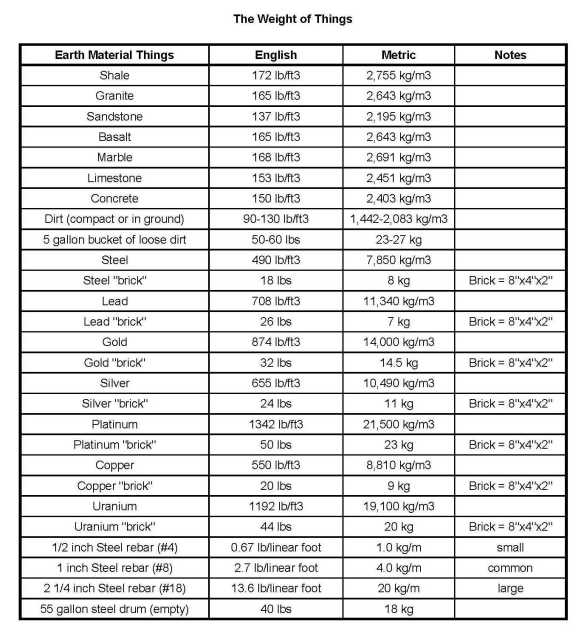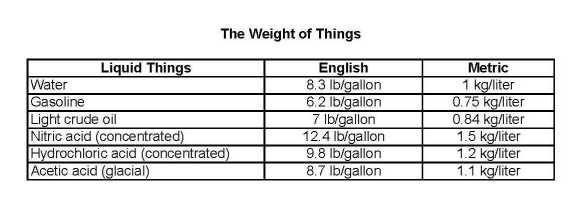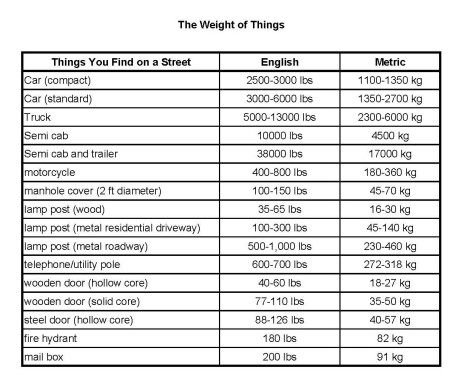The Weight of Things: Liquids
Image
The Weight of Things – Things you find on a street
Image
The Weight of Things: Earth Materials
 Link to Adobe format: Weight of Earth Material Things
Link to Adobe format: Weight of Earth Material Things
The Weight of Things: Introduction
Do you remember the last time you were racing through a back alley and wanted to throw a couch at the night guard to slow them down? Was there twenty minutes of discussion about how heavy a couch is and where does it fit on the tiny strength chart the book gave you?
This series will provide a variety of tables with categories of things that our group has debated weights of in our games as well as some things that just seem useful. These tables will be living documents, so feel free to make suggestions for additions.
My character isn’t a fighter – how can I contribute to a combat?
Question for the GM: When I’m playing a character that doesn’t fight well, I either end up ineffectually flailing at enemies, or doing nothing and waiting until the combat is resolved. How can I contribute to a combat?
This is a common problem that requires GM flexibility to fix, so you might want to point him to this post. One way that games have avoided this problem is by making every character effective in combat (D&D 4e, Werewolf). While this solves the problem, it can limit dramatic situations that can arise and make everyone quick to resort to combat to overcome problems. At the other extreme, some GMs brag that they run games where combat is rare or non-existent, as if a game without combat is somehow intrinsically better than a game with combat. This has the same problems. The core issue is when a combat system becomes a mini-game that everyone has to stop and play in the midst of a story. When combat is not limited to simply violent physical interaction with enemies, a lot of options open up for characters who can’t or won’t fight. Continue reading
Natural Hazards: Not the end, just a pause.
Updates to the Natural Hazard series is temporarily on hold while I am taking evening classes. Outer space and weather hazards are still in the works, and I’ll add additional suggestions as time permits.
I hope that these articles have already sparked some ideas for realistic hazards for your games. If your game has magic or superhuman powers, feel free to give science a nudge to fit with the style. Experiment with natural hazards to gently nudge your players toward a future plot line or put one out there to see if the players find their own plot line to run with. Either way, natural hazards add depth and character to the world the story is taking place in.
Natural Hazards: Quicksand
An innocent person missteps and starts sinking in quicksand. The hero has to hurry otherwise the person is going to drown! Or, not so much. We have seen this in the movies hundreds of times, but quicksand isn’t a drowning hazard. It’s more of a starving or loosing all our supplies kind of hazard. Quicksand is still good for adding drama and challenges in games, even without the drowning. Continue reading
A New Look at Combat (Part 13): Scaling Up to Mass Combat
A good combat system should be able to scale effortlessly from individual combat, to leading a small unit, all the way up to commanding an army. With this system, keeping the focus on the perspective of the character is what allows it to scale with ease. It’s even possible for characters to participate in different scopes of conflict in the same battle at the same time. Continue reading
Natural Hazards: Geothermal
Since I just finished a great vacation in Yellowstone National Park, here is a brief section on natural hazards associated with geothermal areas. You often see signs in Yellowstone that say “stay on the path”, and for good reason. The ground surface may look solid, but areas are less than an inch think before you crunch into scalding hot water. This water may be inches deep or tens of feet deep. If you are lucky, you get severe burns on a limb. Less lucky…being burnt to death is a pretty painful way to kill off a character. Areas like Yellowstone with geysers and hot springs are rare around the world (about half the known geysers are in Yellowstone), and they are great for games because of that uniqueness. Continue reading



